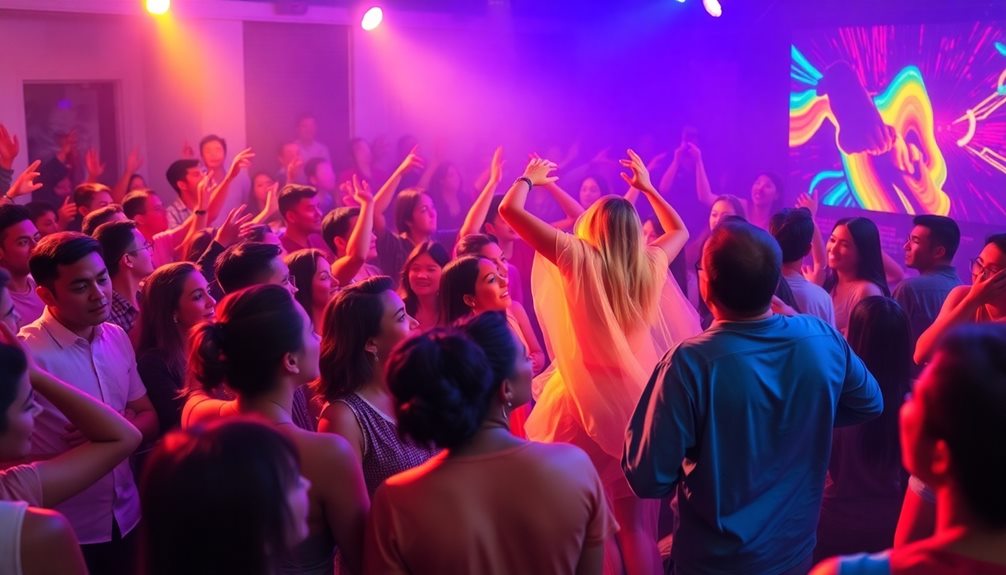Contemporary art spaces prioritize engagement and interactivity, inviting you to connect with living artists and diverse mediums like digital art and performance. They focus on personal experiences and emotional connections, promoting self-directed exploration. In contrast, traditional museums emphasize preserving art history, showcasing valuable collections through guided tours and educational programs. While museums serve as custodians of heritage, contemporary spaces encourage community collaboration and thematic exhibitions that reflect current issues. Each venue offers a different way to experience art, and understanding their distinctions can enhance your appreciation for both. There's much more to uncover about these fascinating environments.
Key Takeaways
- Contemporary art spaces prioritize direct engagement with living artists, fostering individual interpretation and emotional connections through interactive and immersive experiences.
- Traditional museums focus on preserving art heritage, showcasing historical works while providing educational programming to deepen understanding of art history.
- Audience participation is crucial in contemporary art spaces, where interactive exhibits allow visitors to influence outcomes, unlike the more static displays in traditional museums.
- Accessibility and inclusivity are emphasized in contemporary art spaces, encouraging diverse community involvement through free events and welcoming environments.
- Future directions for both spaces include integrating technology and interdisciplinary approaches to enhance visitor experiences and attract new audiences.
Defining Contemporary Art Spaces

Contemporary art spaces are dynamic environments that prioritize direct engagement with living artists and current cultural dialogues. Unlike traditional museums, which often stick to historical narratives, these contemporary art museums embrace thematic and issue-oriented exhibitions that reflect pressing global issues and societal complexities.
You'll find that these spaces encourage individual interpretation and self-directed learning, making art accessible and relatable. These venues utilize diverse mediums, including digital art, performance, and installations, allowing for fluid interpretations that defy strict categorization.
By supporting emerging artists and focusing on community accessibility, contemporary art spaces remove barriers to artistic expression, often featuring artist-run initiatives and non-profit centers.
Moreover, the integration of technology enhances audience engagement. Virtual reality experiences and online exhibitions broaden access to contemporary art, inviting you to explore in innovative ways.
This commitment to engagement and accessibility is what sets contemporary art spaces apart, inviting you to be part of the conversation. When you step into these environments, you're not just a viewer; you're an active participant in the evolving narrative of contemporary art.
The Role of Traditional Museums

Traditional museums play an essential role in preserving our art heritage, showcasing works that span centuries and cultures.
They serve as educational spaces, helping you connect with the broader narratives of art history while fostering an appreciation for diverse artistic expressions.
As you explore these spaces, you engage not just with the art itself, but with the cultural and historical contexts that shape it.
Preservation of Art Heritage
Art heritage preservation hinges on the vital functions of museums dedicated to conserving significant works and artifacts. These traditional institutions play an essential role in ensuring that future generations can access and learn from our shared artistic history.
By safeguarding cultural artifacts, they become custodians of art heritage, employing specialized conservators to maintain and restore their collections.
Here are three key ways traditional museums contribute to art heritage preservation:
- Comprehensive Collections: They acquire works through donations, bequests, or purchases, reflecting diverse artistic movements and historical periods.
- Ethical Repatriation: Many museums engage in ethical practices regarding repatriation, returning artworks with contested histories to their rightful cultural contexts when appropriate.
- Contextual Programming: Museums often provide extensive historical context and educational programming, helping visitors understand the broader narratives surrounding the artworks.
Through these functions, traditional museums not only protect but also enrich the appreciation of art heritage.
They connect you to the past, enabling a deeper understanding of the cultural significance embedded in each piece. Consequently, their role in preserving art heritage is indispensable for both current and future generations.
Educational and Cultural Functions
Museums play an essential role in education and culture, serving as gateways that connect you to the rich narratives of artistic expression throughout history. Traditional museums focus on both educational and cultural functions, preserving and exhibiting art while showcasing the broader context of art history. By curating collections that span historical and contemporary works, these institutions provide a structured approach to understanding artistic development over time.
Additionally, just as in retirement planning, where proper strategies can maximize benefits, museums also employ strategies to enhance your engagement and learning experience, ensuring that art remains accessible and relevant maximize benefits.
Traditionally, museums aimed to educate visitors about cultural heritage, memorializing national spirit and fostering community identity. They serve as centers for learning, engaging you through guided tours, workshops, and lectures that promote critical thinking and deeper appreciation for the arts. As you explore these spaces, you gain insights into the cultural significance behind each piece and the artists' intentions.
In recent years, the role of traditional museums has evolved. There's a growing emphasis on inclusivity and diverse narratives, allowing you to connect with a wider range of experiences and societal issues.
This shift not only enriches your understanding of art but also reflects the contemporary world in which you live, making museums crucial educational hubs for all.
Audience Engagement in Art

When you step into contemporary art spaces, you often find interactive experiences that invite you to engage in unique ways.
These environments encourage diverse audience participation, allowing everyone to connect emotionally with the art on display.
This shift from traditional approaches fosters a deeper relationship between you and the artwork, making each visit a personal journey.
Interactive Art Experiences
Interactive art experiences have revolutionized the way audiences engage with creative works, turning spectators into active collaborators. In contemporary art spaces, you're no longer just a passive observer; you're invited to participate, creating a deeper connection to the artwork.
This shift is fueled by technology and innovative practices that challenge traditional art viewing.
Here are a few key aspects of interactive art experiences:
- Audience Participation: You can influence the artwork's outcome, blurring the lines between creator and viewer.
- Immersive Technology: Many art galleries now use augmented reality and virtual tours to enhance engagement, making your experience more memorable.
- Community Collaboration: Workshops and community-driven projects encourage dialogue, allowing diverse voices to contribute to the artistic narrative.
Research shows that interactive exhibits greatly boost visitor satisfaction, with 80% of participants preferring hands-on experiences.
This trend highlights a collective desire for more engaging, meaningful interactions with art. As you explore contemporary art spaces, embrace these opportunities to not just observe, but actively shape and influence the art around you.
Diverse Audience Participation
Engaging with art in contemporary spaces opens up a world of diverse audience participation, allowing you to explore and connect with artistic expressions on a personal level. Unlike traditional museums that often focus on memorializing national spirit, contemporary art spaces prioritize your individual experience and self-directed learning. This shift empowers you to engage with modern and contemporary art in ways that resonate uniquely with your background and interests.
Initiatives like the Morris-Jumel Mansion's reinterpretation plan showcase how blending contemporary art with historical narratives fosters dialogue, enhancing your engagement with diverse artistic expressions. Innovative programs, such as the Contemporary Meets Colonial Series, highlight community collaboration with local artists, drawing you into cultural events that reflect your community's diversity.
Moreover, the decline of rigid historical narratives in museums has paved the way for thematic and issue-oriented exhibitions that spark your curiosity and exploration. By utilizing technology and social media, organizations like One River School enhance outreach, promoting events that make art more accessible.
This approach encourages broader community involvement, ensuring that diverse audience participation thrives in contemporary art spaces.
Emotional Connections With Art
Art has a unique power to evoke emotional responses, and contemporary art spaces harness this potential by inviting you to engage with artworks on a personal level.
Unlike traditional museums that often focus on historical narratives, contemporary spaces prioritize individual emotional connections. Here, you're encouraged to interpret art through your own experiences, fostering a deeper resonance.
In these dynamic environments, emotional connections can be enhanced by:
- Interactive and immersive installations that draw you in and spark conversations.
- Opportunities for self-directed learning, allowing for personal reflection on themes that matter to you.
- Diverse and inclusive exhibitions that reflect a wider range of cultural narratives, making your experience more relatable.
Curatorial Practices Compared

In today's art world, curatorial practices reveal a significant divide between contemporary art spaces and traditional museums. Contemporary art spaces often prioritize thematic and issue-oriented exhibitions, creating an atmosphere where curiosity thrives.
You'll notice that contemporary curators engage directly with living artists, selecting works that provoke thought and challenge societal norms. This approach contrasts sharply with traditional museums, which typically focus on preserving historical artifacts and artworks.
The dynamic nature of contemporary art allows curators to adapt exhibitions to reflect current cultural and social contexts. You'll find that these spaces often embrace collaboration with local communities, promoting inclusivity and diverse narratives.
In contrast, traditional museums can feel more exclusive and static, adhering to linear historical timelines.
While technology enhances engagement in contemporary curatorial practices, traditional museums lean more on physical displays and conventional visitor experiences.
This difference shapes how you interact with art, as contemporary art spaces invite you to explore and question, while traditional museums often present a curated historical narrative.
Ultimately, these contrasting curatorial practices influence your understanding and appreciation of art in meaningful ways.
Impact of Technology

The influence of technology on the art world is reshaping how you experience and engage with exhibitions. Digital advancements have opened doors to global audiences, enabling you to explore online exhibitions and interact with art in ways that go beyond the physical space.
With the integration of AI and data analytics, museums can now tailor exhibitions to your preferences, enhancing your overall experience.
Here's how technology is revolutionizing your engagement with art:
- Virtual Reality (VR): Immerse yourself in innovative experiences that challenge traditional notions of authenticity.
- Interactive Exhibitions: Participate in thematic, issue-oriented displays that promote curiosity and self-directed learning.
- Social Media Outreach: Connect with diverse communities and stay informed about exhibitions, allowing you to engage with art in real-time.
As museums increasingly harness technology, they foster an atmosphere of exploration and connection.
You can look forward to a more personalized and engaging experience that adapts to societal changes while making art accessible to everyone. Technology isn't just a tool; it's a bridge that connects you to the art world in exciting new ways.
Accessibility and Inclusivity

Accessibility and inclusivity stand at the forefront of contemporary art spaces, inviting everyone to engage with creativity on their own terms. Unlike traditional museums, these spaces often prioritize free or low-cost events, breaking down economic barriers. Volunteer-run spaces and artist-run initiatives (ARIs) foster community engagement, allowing diverse audiences to interact with emerging artists outside commercial norms.
Contemporary venues actively work to remove intimidation factors, creating welcoming environments. This encourages visitors from various demographic groups to explore art without feeling alienated. Educational programming increasingly focuses on self-directed learning, empowering you to engage with art in your unique way.
Here's a quick overview of accessibility features in contemporary art spaces:
| Feature | Benefit |
|---|---|
| Free/Low-Cost Events | Reduces economic barriers for visitors |
| Volunteer-Run Initiatives | Enhances community engagement |
| Welcoming Environments | Minimizes intimidation and encourages exploration |
| Online Exhibitions | Broadens access regardless of location |
Through these efforts, contemporary art spaces guarantee that everyone can appreciate art, fostering a sense of ownership and connection.
Future Directions in Art Spaces

Art spaces are rapidly evolving to prioritize community engagement and adaptability. As you explore contemporary art in these settings, you'll notice an increasing collaboration with local organizations, enhancing visitor diversity and participation. This shift not only enriches the art experience but also fosters a sense of belonging within the community.
Key future directions include:
- Integration of contemporary art in historic settings, creating dialogues between different artistic eras.
- Digital advancements that transform visitor experiences through online exhibitions and virtual reality, making art accessible beyond physical spaces.
- Interdisciplinary approaches, allowing museums to adapt to societal changes and serve as community hubs for diverse narratives.
These innovative strategies, like using museum spaces for local theater and arts events, break traditional operational norms, attracting new audiences.
Frequently Asked Questions
What Is the Difference of Contemporary Art and Traditional Art?
Contemporary art focuses on current issues and diverse mediums, while traditional art emphasizes historical styles and aesthetics. You'll notice that contemporary works often invite dialogue, whereas traditional pieces reflect established movements and emotional expression.
What Is a Contemporary Art Museum?
A contemporary art museum showcases works by living artists, reflecting current cultural and social contexts. You'll experience diverse artistic expressions that provoke thought and encourage dialogue about relevant themes, making art accessible and engaging for everyone.
What Is a Typical Difference Between an Art Museum and an Art Gallery?
Think of a vast library filled with stories—that's an art museum. In contrast, an art gallery resembles a cozy bookstore, showcasing specific tales. One preserves history; the other promotes individual narratives, creating unique experiences for you.
Why Do People Go to a Contemporary Art Museum?
You visit contemporary art museums to connect with living artists and their diverse works. Engaging with thought-provoking exhibitions and immersive installations sparks personal reflection, making your experience unique and relevant to today's cultural conversations.
Conclusion
As you wander through the forest of art, you'll find contemporary spaces like vibrant wildflowers, bursting with color and life, while traditional museums stand tall like ancient oaks, steeped in history. Each has its own story to tell, inviting you to explore and engage in different ways. As the seasons change, so too will these spaces, intertwining their roots to create a landscape rich in diversity, ensuring that every voice can resonate in the symphony of creativity.









